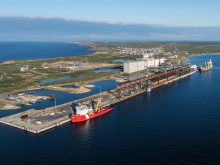What is the future of peas?
There is speculation about pea acreage this coming season.
The Saskatchewan Pulse Growers group raised a few eyebrows last week when it said pea plantings in the province could be as high as 1.66 million acres, an increase of 11 percent over last year.
This is more optimistic than what Agriculture Canada predicted in December. It said acreage across the Prairies would be down by 20 percent.
The growers’ prediction is based on data collected from more than 800 pulse farmers surveyed at 12 meetings across Saskatchewan in January and early February.
Read Also

U.S. market can’t easily be replaced
The deputy chief economist of Farm Credit Canada says 92 per cent of Canada’s total exports to the U.S. went into the country duty-free in June.
In a news release, the pulse growers say it might seem unlikely that acres will increase when carryover is expected to be a record. But since cereal prices have been dropping almost nonstop for months, producers are looking for alternatives.
Garth Patterson, the organization’s executive director, said peas have a stable yield across a range of environments. Also, the benefit of peas’ nitrogen fixing ability to the following crop in a rotation is becoming popular, he said.
But Brian Clancey, whose Stat Publishing newsletter (www.stat
pub.com) out of Vancouver analyzes pulse markets, believes the survey results are suspect.
He said price projections for new-crop canola and flax are more attractive than for peas, so oilseeds should pick up acreage from cereals.
And producers will think twice about growing more peas when they look at the amount expected to be still in their bins at the end of the crop year, he said in a Feb. 20 newsletter.
Prices for peas in Europe are not strong, Clancey added. What’s worse, low values are not attracting buyer interest and some analysts doubt if sales targets to Europe will be met.
So there is a question whether producers should boost acreage. The Western Producer’s conversations with a few provincial extension agrologists in eastern Saskatchewan suggest that while established pea growers might not expand acreage, there have been many inquiries from producers who want to see if the crop will benefit their rotations.
As for other legumes, the Saskatchewan Pulse Growers expect lentil acres to fall 17 percent. Low green lentil prices combined with a reduced Eston stockpile means the mix might shift to more Estons and Red Wings in 1998.
Newer chickpea varieties have attracted many and the pulse growers expect plantings to more than double to about 70,000 acres.














